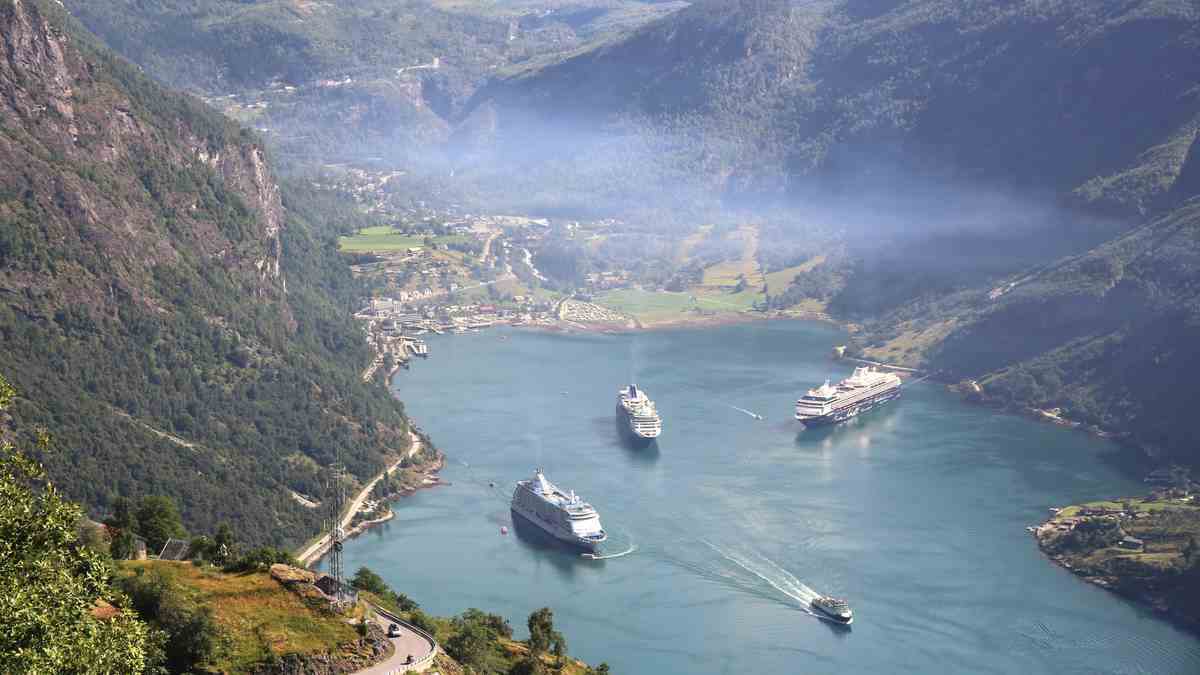In Geiranger it is quiet on the fjord, without a single cruise ship. It can also be like this in the summer. From 2026, all cruise ships visiting the world heritage fjords Geirangerfjorden and Nærøyfjorden must be emission-free. The problem is that few ships have the technology and thus they cannot come. – It is dramatic that they go in to affect these iconic local communities. It is also a moral question, says Inge Tangerås, day-to-day manager of Cruise Norway. Inge Tangerås in Cruise Norway says that the cruise industry is working to reduce the cut significantly globally. He thinks it will be wrong that the world heritage fjords have to be cut earlier than others. Photo: Kai Rune Kvitstein / news He thinks it is unfair to set demands that the world heritage fjords should have zero emissions soon, when there are not the same demands elsewhere. – Now some fjords are unfairly hit hard without getting the big climate benefits, Tangerås believes. He emphasizes that work will be done diligently to drastically cut emissions in cruise and ship traffic worldwide by 2030. – No ships after 2026 The Norwegian Maritime Directorate will not postpone the emission requirements for cruise ships in the world heritage fjords in Western Norway. This is revealed in the directorate’s new report, which is now due for consultation. Since most large cruise ships cannot sail emission-free, the directorate proposes that the ships should be able to use biogas as an interim arrangement until 2035. Today there are 15 ships in the world that can use biogas. At the same time, 27 ships are under construction. Port manager Rita Berstad Maraak says that it means little for Geiranger because these ships are too big to be able to enter the fjord. Usually 175 cruise ships come to Geiranger each year. They report that they will arrive 2-3 years in advance. In 2023, 191 cruise ships are expected for the municipality, and in 2024, 150 will arrive. Due to strict environmental requirements, only 50 have signed up for 2025. – In 2026 we have zero calls. It will be challenging, says Maraak. She does not understand the logic of closing cruise traffic in one fjord and thus moving the discharge to another. It was announced that there will be new requirements for the industry in 2018, and for the port manager in Geiranger it was easy to have something concrete to take care of. But at the same time she is worried about what the proposal could lead to. – It is important to obtain facts and find good solutions together with those who will decide, says Rita Berstad Maraak. Photo: Remi Sagen / news Fears for the jobs Up to 800,000 tourists visit Geiranger in the course of a year, and about a third of these are cruise tourists. The new emission requirements make people in the village fear for their jobs. – The cruise industry provides many ripple effects to the local business community. Many jobs will be lost, or will be moved out of the village. Many will lose their income and livelihood, says Geir Gjørva, who works as a shipping agent. He would have preferred to see the introduction of the requirement postponed. – We are working towards a common goal with a cleaner cruise industry, but neither the owners’ association nor the ship is ready yet. It takes time to develop the technology and introduce it, says Gjørva. There have been cruise ships in Geiranger for over 100 years. – Skipa somehow belongs in the image of Geiranger, believes Geir Gjørva. Photo: Remi Sagen / news Large financial losses Trygve Skjerdal (Sp) is mayor of Aurland. He will ask for a meeting with the ministry to show what the effect of zero emissions will be for the municipality and business. Photo: Arne Stubhaug / news In Aurland municipality, there are fears that 60 jobs will disappear when the number of cruise passengers drops dramatically. Mayor Trygve Skjerdal understands the intention of zero emissions and wants to be part of the green shift, but thinks the technology must be in place first. – The way it is now, it will have huge consequences, both financially and practically. In the worst case, we may have to discontinue a very good industry, which gives us good income, a very good reputation in one of the best ports we have in Norway and perhaps the world when it comes to cruise calls, says Skjerdal. According to an analysis from the consulting company Menon, there will be 131-171 fewer jobs in Geiranger and Flåm in 2026. State Secretary Aleksander Øren Heen (Sp) in the Ministry of Climate and Environment wrote to news that they have received the proposal from the Norwegian Maritime Directorate. He says they will consider this carefully. – For us, it is important to find a way forward that can fulfill the Storting’s decision on both zero emissions and further tourism activities in the world heritage fjords. New technological solutions, such as biogas, can be the right way to achieve this, he says. Katrin Blomvik Bakken of Stiftinga Geirangerfjord Verdsarv is positive that polluting cruise ships are not allowed to come. Photo: Remi Sagen / news Good for clean ships Not everyone in Geiranger sees the new requirements in a negative light. The management of Stiftinga Geirangerfjord Verdsarv believes it is positive that the village will in future be visited by the cleanest ships available. – This will mean that we will become one of the cleanest travel destinations in the world. It will open up new opportunities for green value creation for the local community and the business world, says Katrin Blomvik Bakken, director of the foundation.
ttn-69
Cruise traffic can come to an abrupt halt here

